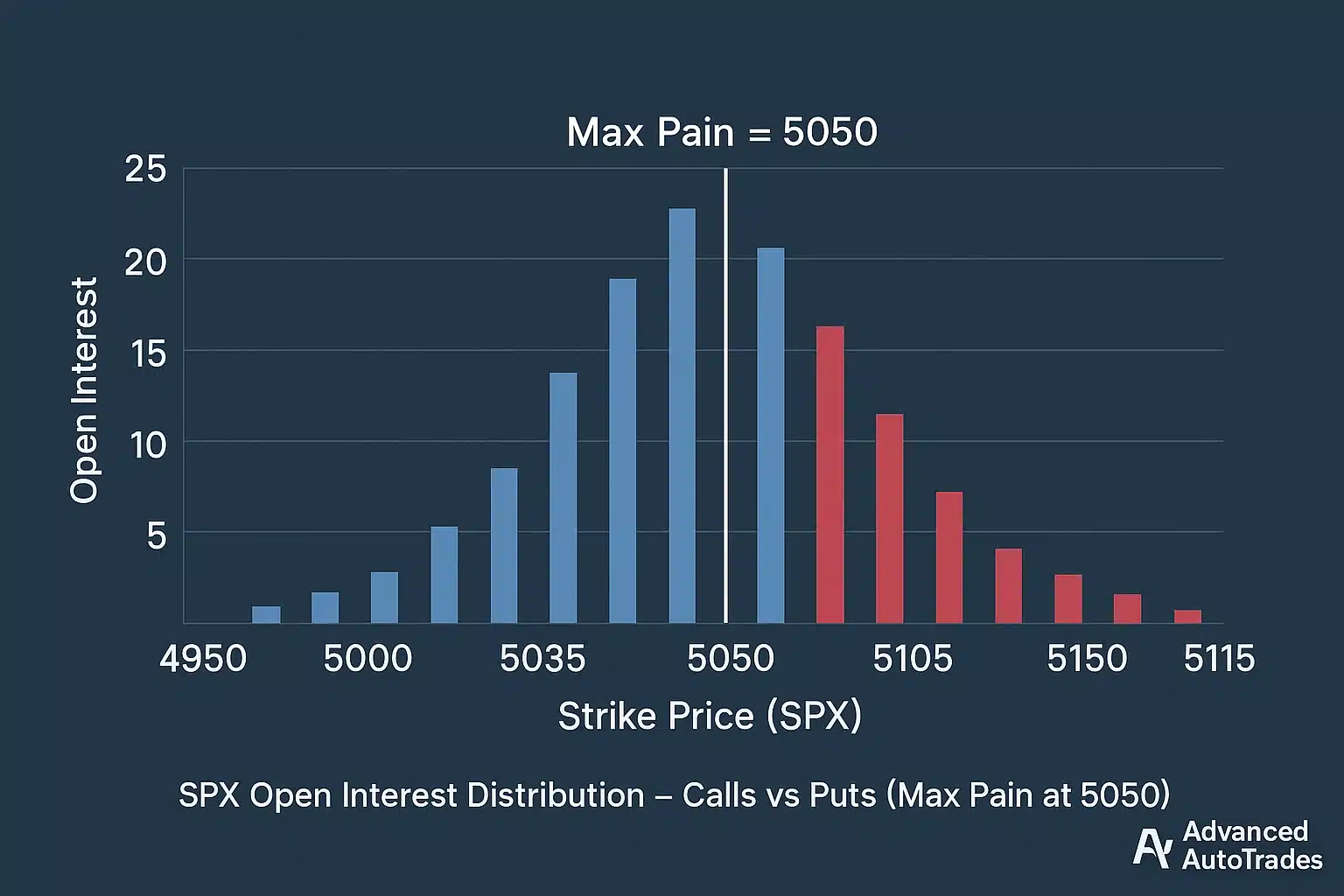When I first heard about the max pain strategy, I thought it sounded dramatic — like something out of a movie. But in reality, it’s one of the most logical tools in options trading, especially for SPX and SPY. It helps traders understand why prices often seem to “magnetize” toward a certain level as options expiration approaches.
In this guide, I’ll break down what the max pain really means, how it’s calculated, and how traders (including myself) use it to make better expiry decisions. No complicated math — just real-world insight from the trading floor. Read on to learn more.
What Is the Max Pain Strategy?
Let’s start with the basics. The max pain strategy, sometimes called the “options max pain theory,” suggests that the price of a stock or index often gravitates toward the strike price where the greatest number of options — both calls and puts — will expire worthless. In simple terms, this is the level where most options buyers feel the “pain,” and market makers (who sell most of those options) feel the least.
So, when you see prices drifting toward one key level on expiration Fridays, it’s often not random. It might just be the max pain effect at work. Why does it matter? Because this tendency can help traders like us anticipate potential price behavior near expiry — especially in SPX options trading and SPY ETFs, where liquidity is massive.
How Max Pain Is Calculated
Here’s where traders get analytical. The max pain calculation is based on open interest — the number of outstanding options contracts at each strike price. To find it, traders use the following steps:
- List all call and put open interest by strike.
- Multiply each by how far that strike is from the current price (if expired now).
- Add the results for each strike.
The strike with the lowest total combined value is the max pain price, the point where the least amount of money would be paid out to option holders and, theoretically, where the underlying could settle.
SPX Max Pain Example: How It Works in Practice
Let’s say SPX is trading at 5050 on Thursday before expiry. The largest call open interest sits at 5100, and the largest put open interest sits at 5000. When you crunch the numbers, the model shows SPX max pain around 5050.
So, if the market starts drifting toward that level on Friday, it might not be a coincidence — it’s a reflection of how market makers adjust hedges to minimize exposure.

SPY Max Pain Example: Why It Often Matters on Expiry Friday
Imagine SPY is trading at 510 before expiry, and most open interest is clustered between 508 and 512. The SPY max pain level might fall around 510 — the middle ground. Notice how often SPY hovers near that zone during the final trading hour before options expire? That’s max pain in action.
Why Markets Gravitate Toward Max Pain
Now, here’s the interesting part about why this happens. It’s not magic — it’s math and market structure.
Market makers who sell options hedge their positions to stay neutral. As expiration approaches, they may buy or sell the underlying to offset risk as open interest shifts. That hedging pressure can pull prices toward the max pain options level. Think of it like gravity: the more open interest at a certain strike, the stronger the gravitational pull toward it.
But remember, max pain isn’t always right. News, earnings, or macro events can overpower it. It’s a tendency, not a guarantee — useful for context, not prediction.
How to Use the Max Pain Strategy in an Options Expiry Setup
So how can traders use it effectively? When I plan my options expiry strategy, I always check the options max pain chart before Friday’s close. It helps gauge whether the market is likely to drift or stay pinned.
Here’s how I typically apply it:
- If the market is above the max pain level, I watch for mild downside pressure.
- If it’s below, I look for a possible upward drift.
- If it’s near the max pain level, I expect consolidation.
This approach helps position my SPX or SPY trades accordingly — especially when setting up credit spreads or iron condors that thrive in sideways price action. It’s not about predicting direction — it’s about stacking probabilities in your favor.
How Max Pain Fits With Defined-Risk Strategies
Here’s where things come together. The max pain strategy complements defined-risk setups like bull put spreads, credit spreads, or iron condors. Why? Because those strategies perform best when price stays within a controlled range — exactly where the market often settles near max pain.
For example, if the SPX max pain level sits around 5050, and you have a neutral iron condor built between 4950 and 5150, you’re perfectly aligned. Time decay works for you, and price staying near max pain can boost your odds.
This is also where automation helps. Platforms like Advanced AutoTrades use data-driven systems to track open-interest shifts and volatility changes — helping traders manage or adjust their setups more efficiently.
Limitations and Best Practices
- It’s a guide, not a signal: Treat max pain as helpful context rather than a stand-alone trigger.
- Always consider market context: Volatility, trend, momentum, and macro news can override the pinning effect.
- Be cautious with ultra short-dated trades: Same-day (0DTE) options can move fast; use strict risk controls.
- Combine with technicals: Align max pain with support/resistance, volume shelves, or moving averages.
- Review weekly: Open interest can migrate; recheck levels into expiry.
For background on the concept, see Investopedia’s overview of the Max Pain Theory.
Final Thoughts
The max pain strategy gives traders a practical read on where the market may “want” to settle as expiry nears. It’s not perfect, but used with discipline and context it can sharpen your expiry planning for SPX and SPY options.
If you prefer to skip the guesswork, automation can help. Automate your Iron Condor and expiry trades with our Weekly Premium SPX Signals — defined risk, no guesswork, and real trade alerts from professionals who’ve done it for decades.

